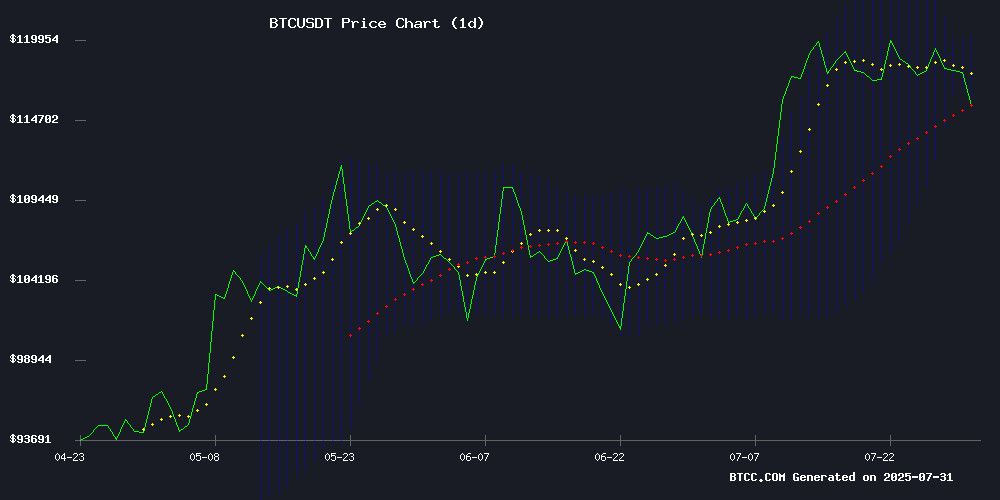Bitcoin Price Forecast: Can BTC Hit $200K by 2030 as Institutional Demand Soars?
- Current Bitcoin Market Overview
- Technical Indicators: Bullish or Bearish?
- Institutional Demand: The Supply Shock Thesis
- Macroeconomic Headwinds
- Long-Term Price Projections
- Frequently Asked Questions
As Bitcoin consolidates near $118,000, analysts are debating whether the cryptocurrency could reach $200,000 amid growing institutional adoption. The BTCC research team examines key technical indicators, macroeconomic factors, and supply dynamics that could propel BTC to new highs. With MicroStrategy's aggressive accumulation, potential US government Bitcoin reserves, and tightening supply, the stage might be set for a historic rally—but Fed policy and dollar strength remain wild cards.
Current Bitcoin Market Overview
Bitcoin (BTC) is currently trading at 118,639.78 USDT, showing neutral-to-bullish signals as it hovers above its 20-day moving average (118,340.93). The MACD histogram displays positive momentum at 1,936.34, while Bollinger Bands suggest consolidation with prices NEAR the middle band (116,760–119,921 range). This comes as institutional players like MicroStrategy continue accumulating BTC, having recently purchased 21,000 BTC for $2.4 billion—bringing their total holdings to 628,791 BTC with $28.18 billion in unrealized profits.

Technical Indicators: Bullish or Bearish?
The technical setup presents mixed signals. While the MACD shows bullish momentum, the Relative Strength Index at 61 indicates neutral territory. Key support levels include the 50-day EMA at $115,000 and the 100-day EMA at $111,000. The $120,000 resistance level has proven formidable, with multiple failed breakout attempts creating selling pressure. However, long-term moving averages maintain their upward trajectory, suggesting underlying strength.
Institutional Demand: The Supply Shock Thesis
MicroStrategy's aggressive accumulation strategy highlights growing institutional interest. With exchange reserves dwindling and the next halving event approaching in April 2024, analysts like Max Keiser suggest we might see an "artificial halving" effect as corporate demand collides with reduced miner issuance. The US government's potential bitcoin reserves (estimated at 198,000 BTC) could further tighten supply. Santiment data reveals whales now control 68% of circulating BTC—a 218,570 BTC increase since March—signaling a shift toward patient capital driving the market.
Macroeconomic Headwinds
The Federal Reserve's decision to maintain interest rates at 4.25-4.5% has strengthened the US Dollar Index (DXY) to 99.98, creating temporary pressure on Bitcoin. Fed Chair Jerome Powell's ambiguous stance on future cuts has reduced September rate cut odds to 41%, down from 90% a month ago. This monetary policy uncertainty has left BTC range-bound, though analysts note the market quickly absorbed a recent 80,000 BTC sell-off from a Satoshi-era wallet—demonstrating resilient demand.
Long-Term Price Projections
Ark Invest CEO Cathie Wood projects a 1900% appreciation for BTC by 2030, citing its store-of-value properties and institutional adoption. The BTCC team notes that while short-term resistance at $120,000 persists, the combination of technical indicators and macro tailwinds could fuel a rally toward $200,000. Key factors to watch include:
| Indicator | Value | Implication |
|---|---|---|
| 20-day MA | 118,340.93 | Support level |
| MACD | 1,936.34 (positive) | Bullish momentum |
| Bollinger Bands | 116,760–119,921 | Consolidation range |
Frequently Asked Questions
What's driving Bitcoin's potential rally to $200,000?
The convergence of institutional accumulation (like MicroStrategy's 628,791 BTC holdings), supply constraints from the 2024 halving, and growing recognition as a strategic asset (including potential US government reserves) could create perfect storm conditions for a parabolic move.
How does Fed policy impact Bitcoin's price?
Bitcoin has shown inverse correlation with the DXY. The Fed's current hawkish stance (holding rates at 4.25-4.5%) strengthens the dollar, creating short-term pressure. However, any future rate cuts could trigger significant BTC upside.
Are whale movements concerning?
While recent activity includes a Satoshi-era wallet moving 250 BTC, the market absorbed a massive 80,000 BTC sell-off with minimal price impact—suggesting strong underlying demand that may support higher prices long-term.
What are the key support/resistance levels?
Critical support lies at $115,000 (50-day EMA) and $111,000 (100-day EMA). The $120,000 resistance remains the key level to watch—a decisive break could open path to $150,000 and beyond.

